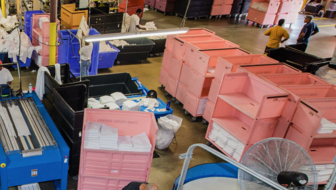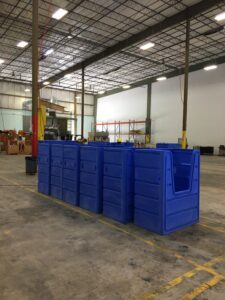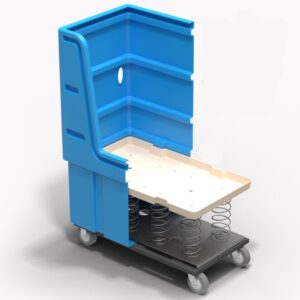
By Dan Rodriguez, Director of Sales and Marketing, Carts and Material Handling, Tank Holding
In Part One of “Selecting the Right Laundry Cart,” we looked at different types of laundry carts available on the market today. In Part Two, we reviewed various cart characteristics. In Part Three, we’ll discuss specifics on how to buy laundry carts that even experienced laundry professionals and purchasing managers may overlook.
Plastic Carts
Getting to know your plastic options
It’s important to know that not all plastics are created equal. Each type of plastic material confers different characteristics to the carts. Though most laundry carts feature polyethylene plastic, the material is offered in several types to suit different products and applications.
- Low-Density Polyethylene (LDPE) offers bendable flexibility with resistance to cold temperatures and direct impacts.
- Linear Low-Density Polyethylene (LLDPE) offers even more bendable flexibility than LDPE plus higher puncture resistance, but it also tends to stretch out under stress and high temperatures.
- High Density Polyethylene (HDPE) delivers high strength and rigidity with superior resistance to cracks and corrosion yet at a lighter strength-to-weight ratio.
HDPE for heavy-duty usage
For most light-duty linen handling needs, carts and utility trucks may be molded using any of these plastic materials. All are waterproof and easy to clean with common chemical cleaning agents. But, for heavy-duty, commercial linen transport where bulk linen carts routinely suffer punishing drops from tailgates, daily bumps and bruises from walls and doors as well as other linen carts, substantial strength and rigidity are needed to handle the regular pounding to ensure they last year after year. HDPE offers the rigidity to keep cart sidewalls straight and stiff without bowing out or warping when loaded to full capacity. Yet
it’s the strength-to-weight ratio where HDPE really excels because it allows the same number of linens per cart to be delivered at a lighter overall weight-per-route-truck. This saves fuel, reduces wear and tear on trucks, makes work a little easier and offers more ergonomic benefits for staffers. HDPE is also an easily recycled material, so it’s an environmentally friendly choice.
Also, consider that if the HDPE isn’t 100% virgin material or if it includes off-grade or wide-spec material, then the strength and rigidity of the finished cart may be compromised. These quality issues need to be addressed before signing a purchase order.
In many cases, the manufacturer or distributor selling the carts neglects to specify the material used, other than simply stating “polyethylene”. It doesn’t necessarily mean the company is hiding it from the customer. Rather, it’s more likely that many customers fail to consider it an important factor when buying carts. Therefore, the company hasn’t considered the importance of naming the material.
Assessing Molding Quality
If we put three or four laundry carts of a similar size and shape side by side, all from different cart manufacturers, what will we see? If we hide the manufacturer’s logo or nameplate, many people who buy laundry carts would have a difficult time telling them apart. It can be even more difficult to tell which carts were molded to higher quality standards than the others since many key factors are not easily seen. These important, hidden factors include those that determine how well a cart performs as well as the expectation of how long a cart will last.
The importance of wall thickness
 Anyone who has worked in the laundry industry knows to check whether the sidewalls bow out when fully loaded. That’s a very visible way to check cart quality. But far fewer people understand the importance of a consistent wall thickness throughout the entire cart body because it isn’t as easy to notice. If the molder fails to use enough plastic material, blends in second quality material or uses worn out tooling, then the plastic material will be distributed unevenly and cause some areas to be thinner than others.
Anyone who has worked in the laundry industry knows to check whether the sidewalls bow out when fully loaded. That’s a very visible way to check cart quality. But far fewer people understand the importance of a consistent wall thickness throughout the entire cart body because it isn’t as easy to notice. If the molder fails to use enough plastic material, blends in second quality material or uses worn out tooling, then the plastic material will be distributed unevenly and cause some areas to be thinner than others.
These thinner areas create weak spots that invite cart failure. Carts that fail from a wall breaking or collapsing can cause very dangerous situations. These weak spots are hard to see but, depending on the color of the cart, any weak spots in the wall thickness may be revealed as patches of translucent or slightly lighter coloration. In assessing the molding quality of fiberglass laundry carts, it’s important to understand the inherent challenges in molding the material. For example, the resins used in manufacturing often continue to cure for weeks after production. This curing process can distort the shape of the cart and create internal stresses that may ultimately lead to cracks and cart failure.
Tight seals = protection
For another sign of pride in quality workmanship, look at how covers, doors, locks and accessories open, close and fit the cart. Do they fit neatly within the laundry cart body instead of lying over the outer edges? If the lid and door are intended to protect linens from theft and inclement weather, then a sturdy, rotomolded lid and door that shuts tightly offers far more protection than a weak assembly that leaves gaps when closed. A tight seal also guards against water infiltration and cold temperatures to prevent the laundry inside from absorbing water and freezing. This allows the cart to be placed outside in locations for route drivers to service. In short, the more valuable the linens, the more important this quality check of the carts becomes. And remember, check that the cart comes with a warranty against defects.
Shelf Materials
In Part 1, we addressed whether and when to use shelf carts to transport linens as opposed to using bulk carts but there’s more to shelf cart and shelving selection to be considered.
 Removable or non-removable shelves?
Removable or non-removable shelves?
Shelf carts are typically offered in a choice of removable or non-removable shelf designs with a choice of plastic or wire metal shelves. Most carts with removable shelves enable the cart to be switched from clean linen delivery to bulk return mode by moving the shelves from a horizontal to a vertical position. Switching the removable shelves can take a few minutes, and many times, once shelves are removed, they often disappear. Matching shelves to their carts also can be a challenge, especially when a variety of cart sizes, styles and brands are used in the same cart fleet.
Easy to clean no matter what
Plastic shelves clean fast and easily, whether fixed or removable, and are compatible with automated cart washers. They’re waterproof and smooth. To combine the advantages of plastic shelves with the convenience of a non-removable design, a recent shelf cart innovation features a non-removable, plastic shelving design that allows the shelves to be switched from the clean linen delivery position to the bulk cart position in six seconds or less.
Get all the information you need
Given that there’s so much more to a laundry cart than the size, shape and material of construction, talking to colleagues at other laundries and to the salespeople who help specify laundry carts every day, offers insider knowledge that isn’t otherwise available. Some companies will have representatives who visit and tour a laundry plant to understand the workflow and measure the route truck dimensions as well as the locations of the wheel wells. They will be able to provide guidance on the cart model and style that would best meet the needs of the operation. To make sure you’re selecting the right cart, test it in the plant as part of the process – or test a number of different carts at the same time. This is the surest way to feel confident when choosing laundry carts.
About the Author
 Dan Rodriguez is Director of Sales and Marketing, Carts and Material Handling at Tank Holding. Tank Holding manufactures high quality, innovative, and rugged laundry and material handling carts and trucks across several brands including Meese, Maxi-Movers, Dura-Cast, and RMI.
Dan Rodriguez is Director of Sales and Marketing, Carts and Material Handling at Tank Holding. Tank Holding manufactures high quality, innovative, and rugged laundry and material handling carts and trucks across several brands including Meese, Maxi-Movers, Dura-Cast, and RMI.
For more information:
Meese: visit www.meese-inc.com call 800-829-4535 or email: customerservice@meese-inc.com
Maxi-Movers: visit www.maxi-movers.com, call 800-275-2436, or email: sales@maxi-movers.com
Duracast: visit www.duracast.com, call 800-683-4116, or email: SalesService@duracast.com
RMI: visit www.rotationalmoldinginc.com, call 310-707-5949 or email: achavis@maxi-movers.com















